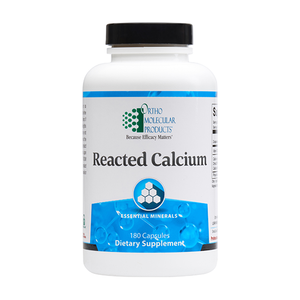
Reacted Calcium, 180 caps
DESCRIPTION
Reacted Calcium provides three unique forms of highly-absorbed calcium to ensure maximum absorption of this important macromineral. While most calcium supplements use only a single source of calcium, which can easily overwhelm a single pathway of absorption and limit uptake, Reacted Calcium takes advantage of three unique pathways of absorption by providing calcium in the hydroxyapatite, di-calcium malate, and glycinate forms. In addition, Reacted Calcium includes vitamin D and phosphorus, both critical nutrients for bone mineralization and remodeling.
- Provides Three Forms of Highly Absorbed Calcium for a Variety of Protocols
- Increases Skeletal Strength and Promotes Healthy Bone Density
INGREDIENTS
Ingredients: Calcium (as Calcium Hydroxyapatite, DimaCal® Dicalcium Malate, TRAACS® Calcium Bisglycinate Chelate, Calcium Citrate USP) 500 mg 38% Vitamin D3 (as Cholecalciferol) 10 mcg (400 IU) 50% Phosphorus (as Calcium Hydroxyapatite)
Formulated to be free of allergens derived from: Gluten, yeast, artificial colors and flavors.
DIRECTIONS
Serving Size:2 capsules
Servings Per Container:90
Suggested Use: 1-2 capsules three times per day or as recommended by your health care professional
If you are pregnant or nursing, consult your physician before taking this product.
Keep container tightly closed. Store at room temperature. Keep out of reach of children.
LEARN MORE
Calcium is required for strong bones, heart health, muscle function, nerve transmission, intracellular signaling and hormonal secretion. It is less than 1 % of total body calcium that supports these critical metabolic functions1 . The body uses bone tissue as a reservoir for calcium, as well as a source of calcium, to maintain constant concentrations of calcium in blood, muscle and intercellular fluids.1 The remaining 99 % of the calcium supply in the body is stored in the bones and teeth, serving as a mineral reserve and structural support for the body.
Statements contained herein have not been evaluated by the Food and Drug Administration. This product is not intended to diagnose, treat, cure, or prevent disease.
Due to manufacturer’s requirements, we are not allowed to ship this product to California.






